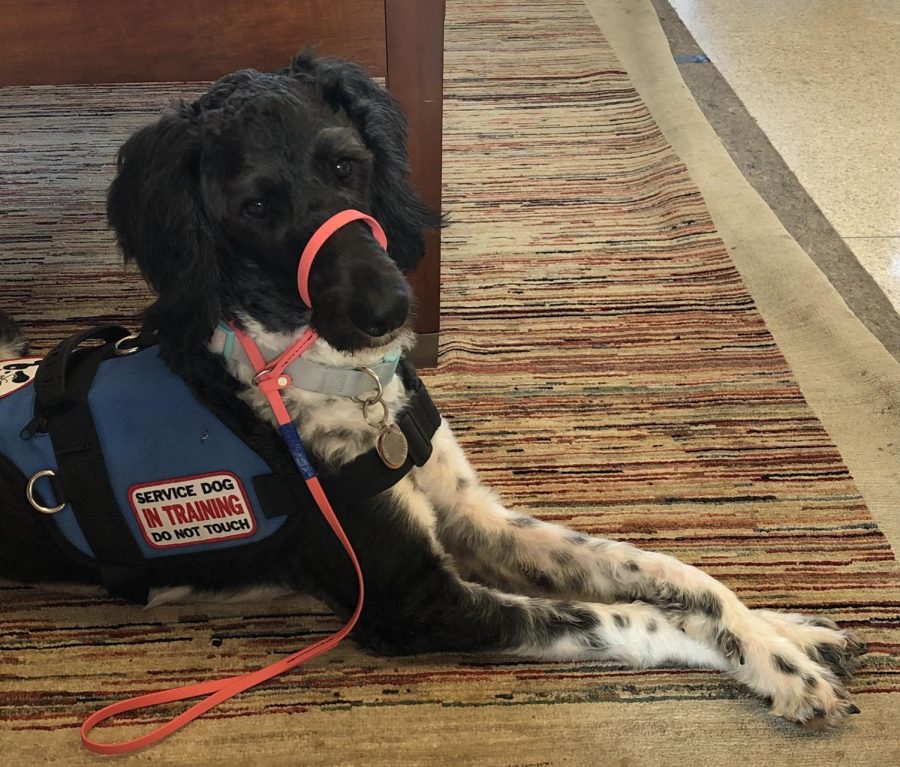“Can I pet your dog?”: A guide to service animal etiquette
Spencer Scruggs, accessibility services director, gives tips on service animal etiquette
Jojo, a good pup and Leo’s service animal.
Chances are you’ve seen a service animal on campus. Maybe you were even interested in learning more about them, but you probably didn’t know the right way to approach their owner, or if you even should.
If you’ve never had personal experience with a service animal, you might not know that Student Accessibility Services deals with all service animal requests and regulations on campus. That’s why Spencer Scruggs, director of Student Accessibility Services, has ample experience to explain what kind of service animals you’ll see on campus and the proper etiquette to deal with them.
All students, staff and visitors have the legal right to have a service animal on campus.
“Service animals are mostly a protection under the ADA (Americans with Disabilities Act) and service animals have been allowed on campus, or any places of public accommodations, since the passage of the ADA,” Scruggs said.
There are technically three different types of animals you could find on campus: Service animals, service animals in training and emotional support animals.
According to Scruggs, a service animal is any animal that falls under the federal definition for a service animal, which is an animal that performs a task that assists an individual with a disability.
Service animals in training are just what they sound like: Service animals that are still working on being officially designated under the federal standard. But for the purpose of their place on campus, there isn’t much difference between service animals and service animals in training.
“Service animals in training technically by federal standards are not included in the definition of a service animal. Now the state of Texas actually adds service animals in training to that definition, so a service animal in training does benefit from the same protections that a service animal would in Texas,” Scruggs said.
Emotional support animals, however, are in a different classification.
“[An emotional support animal] is basically an animal that provides some sort of emotional relief or support to an individual. It’s a federal regulation from Housing and Urban Development,” Scruggs said.
Another difference between service animals and emotional support animals is where you are likely to see them on campus. Whereas service animals can be anywhere on campus, emotional support animals are only going to be allowed in residence halls or outdoor public spaces.
However, whether it’s a service animal, service animal in training or emotional support animal, there are some common guidelines for how to act when you see someone with a potential service animal. For one, there are a couple questions that company and university representatives are allowed to ask.
“Is that animal required because of a disability related reason, and what specific tasks does that animal perform?” Scruggs said.
While those two questions are fine to ask, it’s important to keep in mind the time and feelings of the person you’re asking.
“The other thing is that we encourage not being incessant about it. You know, you don’t want someone asking that question 15 times while you’re walking across campus,” Scruggs said.
If you’d also just like to approach a service animal because you’re interested in them, or they’re just really cute and you want to pet them, it’s OK to approach them if you do it in the right way.
“The most respectable way to ask is to ask the individual who the service animal actually services. Generally, I encourage individuals to ask, do you mind if I pet your service animal?” Scruggs said.
However, the owner of that service animal might not always say yes, and it’s important not to take that personally.
“They may say no, and if they say no, there’s a very good reason why they’re saying it. It might interrupt the kind of service the animal is responsible for, and so asking is really important. And also if the person says no, maybe the person got asked that like 18 times during the day, so that’s annoying to that person,” Scruggs said.
Overall, when dealing with service animals, it’s just important to remember to be respectful of the owner.
“It’s easy for your attention to be drawn to the service animal, but sometimes you need to be more responsive to the actual person who that animal is serving,” Scruggs said.








Todd Smith • Oct 30, 2021 at 12:22 pm
The article, while somewhat accurate, is disturbing in some places. The section about the 2 legally allowed questions is quite disturbing in that it gives the impression that anyone who asks is entitled to answers, instead of an employee/business representative asking as a condition for access.
The general public has no business asking or expecting an answer to the 2 legally allowed questions, as those questions are only to be asked by an official representative of the college.
Artie • Oct 30, 2021 at 12:00 pm
No. Don’t approach us. Interested in Service dogs? There is an amazing device that connects to a worldwide trove of knowledge. Use that instead.
As to the 2 questions, if you are not an employee of the business we are entering, don’t expect us to answer, because we don’t have to. Those 2 questions are for gatekeepers, not a random stranger.
We already have a hard time navigating the world (hence our need for a service dog). Any interaction could lengthen our day, make us loose track of the task we are currently doing or create panic and anxiety for those with social anxiety issues.
We have less spoons then the average person (look up Spoon Theory if you don’t understand), additional interaction can use up precious resources. Because it’s not just one person. And if others ee the interaction they are emboldened to do the same when the team walks near them.
So please, admire from a distance. If you are curious there are many online support groups where you can ask your questions and have multiple handlers answer them.